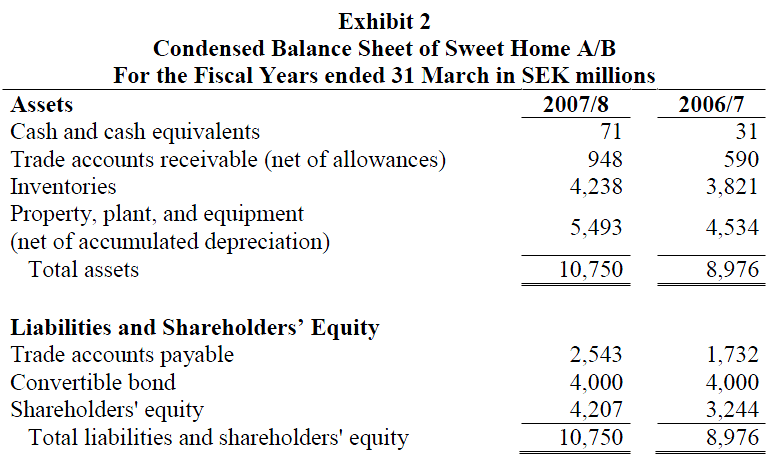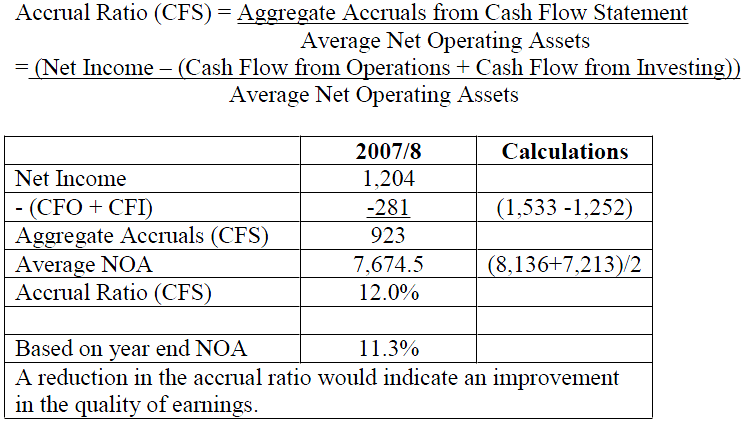Ebba Nyberg Case Scenario
Ebba Nyberg is a fixed income analyst with a Swedish investment firm. Nyberg is analyzing the financial statements of Sweet Home A/B, a Swedish home furniture manufacturer and retailer.
Sweet Home is listed on both the Stockholm and New York stock exchanges and prepares its financial statements in accordance with U.S. Generally Accepted Accounting Principles (U.S.GAAP).
Nyberg’s supervisor, Ander Gustafson, asks Nyberg to continue his preliminary evaluation of Sweet Home’s creditworthiness and quality of earnings. He asks her to examine Sweet Home’s liquidity by calculating its free cash flow to the firm and the quality of earnings by using the cash-flow-statement-based accrual ratios. His initial analysis is contained in Exhibit 1. Nyberg uses the unadjusted financial statements in her initial calculations.
Sweet Home’s financial statements are summarized in Exhibits 2 to 4. Nyberg also uses information from the management discussion and analysis (MD&A) section of Sweet Home’s 2007/8 annual report to adjust Sweet Home’s reported debt, modify its working capital and assess its quality of earnings. The MD&A states:
1. “During 2007/8 Sweet Home guaranteed bank loans of non-consolidated subsidiaries, sold receivables with partial recourse, and took advance payments from large customers when possible.”
2. “Despite overall worsening economic conditions the allowance for doubtful accounts was significantly reduced by SEK 150 million.”
3. “Sweet Home uses the last-in, first-out (LIFO) method for inventories resulting in a reserve of SEK 83 million compared to a first-in, first-out (FIFO) valuation.”
4. “Sweet Home uses declining balance depreciation for all fixed assets except for leasehold improvements which are amortized straight-line over the lease term.”



19. Sweet Home’s 2007/8 free cash flow to the firm (in SEK millions) is closest to:
A. 368.5.
B. 404.5.
C. 506.0.
Answer: B
“Free Cash Flow Valuation,” John D. Stowe, CFA, Thomas R. Robinson, CFA, Jerald E.
Pinto, CFA, and Dennis W. McLeavey, CFA 2009 Modular Level II, Volume 4, pp. 353, 358-364
Study Session 12-42-e Calculate FCFF and FCFE given a company’s financial statements, prepared according to U.S. generally accepted accounting principles (GAAP) or International Financial Reporting Standards (IFRS).
Free cash flow (FCFF) is defined as the cash flow available to the company’s suppliers of capital after all operating expenses (including taxes) have been paid and necessary investments in working capital and fixed capital been undertaken. It can be calculated in two different ways:
[1] from the Income Statement, as Net Income plus net non-cash charges (NCC) plus interest expense (net of taxes) less investment in fixed capital less investment in working capital; or,
[2] from the Cash Flow Statement as Cash flow from Operations plus interest expense (net of taxes) less investment in fixed capital.

20. After completing the analysis Gustafson had started in Exhibit 1, the most appropriate conclusion that Nyberg can make about earnings quality is that it has:
A. improved because it is lower than 0.18.
B. improved because it is higher than 0.18.
C. deteriorated because it is higher than 0.18.
Answer: A
“Evaluating Financial Reporting Quality,” Scott Richardson and Irem Tuna 2009 Modular Level II, Volume 2, pp. 234-248 Study Session 7-26- d Discuss earnings quality, explain simple measures of earnings quality, and compare and contrast the earnings quality of peer companies.

21. Which factor stated in the first quote of the MD&A will Nyberg least likely use to adjust Sweet Home’s reported debt?
A. Guarantees.
B. Sale of receivables.
C. Advances from customers.
Answer: C
“Analysis of Financial Statements: A Synthesis,” Gerald I. White, CFA, Ashwinpaul C.
Sondhi and Dov Fried 2009 Modular Level II, Volume 2, pp. 294-296, 300-303
Study Session 7-27-a
Analyze and evaluate the balance sheet for assets and liabilities that are not recorded, and for assets and liabilities for which the amounts shown on the balance sheet differ from their current values.
Advances from customers are a legitimate liability and should not be part of an adjustment of the firm’s debt. Guarantees represent a contingent liability and need to be included in a firm’s adjusted debt level. Sale of receivables (with recourse) can be thought of as collateralized borrowing and needs to be part of the adjustment to the debt level.
22. Compared to its reported 2007/8 financials, after Nyberg adjusts Sweet Home’s working capital given the second and third quote of the MD&A, the most likely effect will be that:
A. both accounts receivable and inventories will be lower.
B. accounts receivable will be lower and inventories will be higher.
C. accounts receivable will be higher and inventories will be lower.
Answer: B
“Analysis of Financial Statements: A Synthesis,” Gerald I. White, CFA, Ashwinpaul C. Sondhi and Dov Fried 2009 Modular Level II, Vol. 2 pp. 295-300
Study Session 7-27-a, b
Analyze and evaluate the balance sheet for assets and liabilities that are not recorded, and for assets and liabilities for which the amounts shown on the balance sheet differ from their current values.
Analyze and evaluate the balance sheet for the current value of assets and liabilities.
Sweet Home’s reduction of receivables’ allowance should be reversed, given the worsening economic conditions, reducing the net receivables balance; indeed, when customers suffer from financial distress, such as during a recession, an additional loss provision may be required. The LIFO reserve should be added back to inventories, increasing its carrying amount.
23. Compared to its reported 2007/8 financials, if Nyberg adjusts Sweet Home’s financial statements given the second quote of the MD&A, the effect (in SEK millions) on total assets and net income will most likely be a:
A. 150 decrease in both total assets and net income.
B. 97.5 decrease in total assets and no effect on net income.
C. 150 decrease in total assets and a 97.5 decrease in net income.
Answer: C
“Analysis of Financial Statements: A Synthesis,” Gerald I. White, CFA, Ashwinpaul C.
Sondhi and Dov Fried 2009 Modular Level II, Volume 2, pp. 294- 300 Study Session 7-27-a, d
Analyze and evaluate the balance sheet for assets and liabilities that are not recorded, and for assets and liabilities for which the amounts shown on the balance sheet differ from their current values.
Analyze and interpret:
? the effect on reported financial results and ratios of a company’s choices of accounting methods and assumptions;
? the effect on reported financial results and ratios of changes in accounting methods and assumptions;
? the effects of balance sheet modifications and earnings normalization on a company’s financial statements, financial ratios, and overall financial condition.
Sweet Home’s reduction of the accounts receivables’ allowance should be reversed; this would increase the allowance for doubtful accounts by 150 and hence reduce the net receivables balance. So total assets decrease by 150. The adjustment would also require an increase the bad debt expense of 150 which reduces net income by 150(1-.35) = 97.50.
24. Which of the following activities of Sweet Home A/B would least likely indicate a lower quality of earnings for the company to Nyberg? The company’s:
A. sale of receivables with partial recourse.
B. choice of depreciation methods for fixed assets.
C. guarantee of bank loans for non-consolidated subsidiaries.
Answer: B
“Evaluating Financial Reporting Quality,” Scott Richardson and Irem Tuna 2009 Modular Level II, Volume 2, pp. 262-263, 274
“Analysis of Financial Statements: A Synthesis”, Gerald I. White, CFA, Ashwinpaul C. Sondhi and Dov Fried 2009 Modular Level II, Volume 2, p. 315
Study Session 7-26-d, g, 7-27-d Discuss earnings quality, explain simple measures of earnings quality, and compare and contrast the earnings quality of peer companies.
Explain and interpret warning signs of potential problems in each of the major areas of financial reporting (i.e., revenue, expenses, assets, liabilities, and cash flow) and warning signs of overall vulnerability to financial reporting problems.
Analyze and interpret:
? the effect on reported financial results and ratios of a company’s choices of accounting methods and assumptions,
? the effect on reported financial results and ratios of changes in accounting methods and assumptions
? the effects of balance sheet modifications and earnings normalization on a company’s financial statements, financial ratios, and overall financial condition.
Quality of earnings refers to the degree of conservatism in reported earnings.
Accelerated depreciation methods are an indication of high earnings quality; both sale of receivables with partial recourse and guarantees of unconsolidated subsidiary debt represent off-balance sheet financing techniques, which lower the quality of earnings. |

